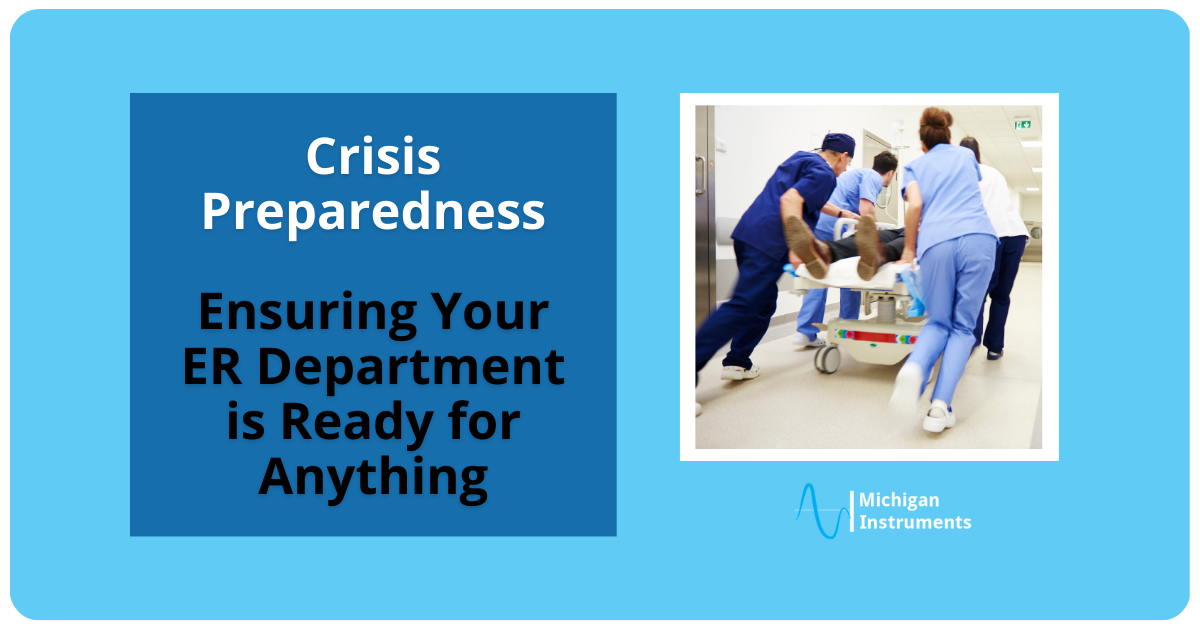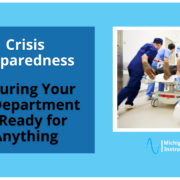
In the fast-paced environment of an Emergency Department (ED), preparation is crucial. From natural disasters to pandemics, a crisis can strike unexpectedly, putting patients and staff at risk, adding additional stress to an already stress-filled environment.
In this guide, we’ll explore essential steps for preparing your ED to effectively manage any crisis that may arise.
Understanding and Identifying Potential Crises and Threats
It’s crucial to understand the diverse range of situations that an ED may face. From mass casualties to infectious disease outbreaks, each crisis presents unique challenges that require different response strategies.
By anticipating each potential scenario, Emergency Departments can better prepare for the unexpected and lessen the impact on patient care. In addition, being prepared reduces the stress and hardship on the staff.
Prepare Your ED for Crisis Management in 5 Steps
In order to better prepare your Emergency Department for a potential catastrophe, it’s crucial to consider five different areas where preparedness is key.
1. Establish a Dedicated Crisis Management Team
Establishing a dedicated hospital crisis management team is the first step to ensuring that your ED is effectively prepared. This team should include representatives from various departments within the facility, as well as external partners, such as emergency services and public health agencies.
Assign clear roles and responsibilities to each team member to ensure a coordinated response. During a crisis, every second counts. Having dedicated team members with outlined responsibilities helps to ensure that all areas are covered.
2 .Develop a Comprehensive Crisis Response Plan
Like a roadmap, a well-developed and thoughtful response plan will help your team members navigate the unknowns of a crisis. Be sure to discuss and plan for communication protocols, resource allocation strategies, patient triage procedures, and evacuation plans.
Once the plan is established, perform regular drills and simulations to help staff familiarize themselves with the protocols, which will ensure that the plan is effectively executed in the event of a crisis.
3. Enhance Infrastructure and Strengthen Resources:
One of the major concerns during a crisis is being able to maintain continuity of care to the patients. In order to ensure that your Emergency Department is properly equipped to continue care in the event of a crisis, adequate infrastructure and resources are essential.
This includes stockpiling medical supplies and equipment, optimizing your facility’s design for efficient patient flow, and leveraging technology for streamlined monitoring and communication.
Products like Automatic CPR Machines, the Life-Stat and Thumper CPR devices, are two examples of technological enhancements that would enhance continuity of care and free-up staff to tend to other issues. Investing in these resources will allow your EDs to better withstand the demands of a crisis situation.
4. Empower Staff Through Training and Education
A critical step of ensuring that your Emergency Department is prepared for anything includes equipping and empowering them to spring into action when disaster strikes.
This includes ongoing training, education, emergency response drills, and medical simulation exercises. Hands-on training is especially crucial in empowering staff to feel confident and comfortable carrying out their required duties during a crisis.
5. Collaborate and Build Partnerships with Community Organizations
Finally, forge relationships with local emergency services, other hospitals, and community organizations. These outside partnerships are essential to enhance your ED’s crisis preparedness, offering access to additional support and resources during times of crisis.
By banding together, your Emergency Department and community will be more resilient and better equipped to weather any storm.
Careful Planning is Necessary to Prepare Your ED for Crises
Preparing an Emergency Department for hospital crisis management is a multifaceted endeavor that requires careful planning, coordination, and collaboration.
By using the 5 steps listed here, you can ensure that your EDs are ready to face whatever challenges come their way.
Taking the Next Step to Prepare Your Emergency Department for Crisis Management
Are you ready to take the next step in preparing your Emergency Department for crisis management? Review your current preparedness plans, identify areas for improvement, and take proactive steps to enhance your readiness.
Thousands of emergency medical professionals and emergency directors have chosen to partner with Michigan Instruments as a trusted source for automatic CPR machines. By equipping your Emergency Department with reliable equipment like ours, you can enhance your ability to respond effectively to crises and save lives.
Together with Michigan Instruments and other partners, we can build safer, more resilient communities. Contact us today for more information.




